
Exchange-種を植える
2013年10月26日(土)~12月15日(日)
air2013-3ja
山崎 阿弥
YAMASAKI Ami
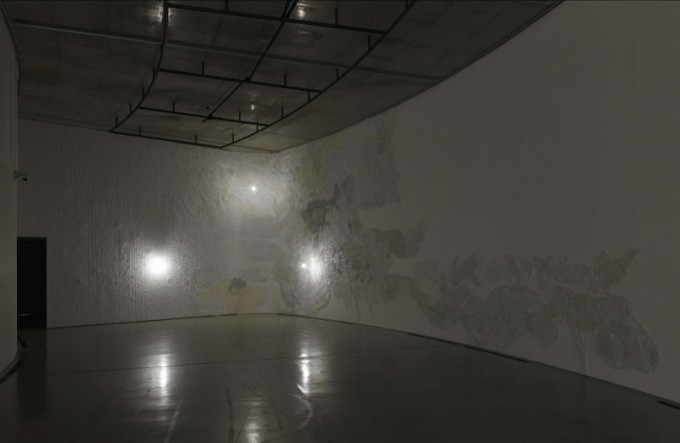
《ソング / もとのけもの, リズム》 撮影:山本糾
生成の場所
近藤由紀
ACACのギャラリーAは、高さ6mのドーナツ型の半円形という形状から特異な音響特性を備えている。形状によって複雑に反射する音は、思わぬところから遅れを伴って聞こえたり、入口付近で話された小声が急なカーブを回り、入口からは見えなくなっている出口付近で横に立って話されているかのように聞こえたりする。そのためギャラリー内ではその残響によりドラマティックな音の響きが作られる一方で、テンポの速い楽曲などは、ディレイと反射により元のメロディが分からなくなるほど音が混ざってしまう。さらに音源から音が均一に拡散しないので、立ち位置によって聞こえる音が微妙に異なる。
「声のアーティスト」として活動している山崎阿弥は、声を中心に活動を行うアーティストということもできるだろう。声を使ったパフォーマンスが行われる時も、しばしば作品として制作された映像やインスタレーションを合わせたり、録音された音やコップや貝などから出した音などを合わせたりしており、それらの相互作用によって「作品」としての空間と時間が組み上げられていく。「耳・声帯・皮膚を聴覚器官として用い」(1)、音を知覚するという山崎は、このACACの音響空間と対話することから《ソング/もとのけもの,リズム》の制作を始めた。山崎は何もないギャラリー内で高低や強弱を変えながら発声し、それらがどこでどのように反射/反響するのかを確かめていく。そしてこの感得した響きの違いを「陰影」と捉え、それを山崎が「羽根」と呼ぶ、細長い三角形状に小さく千切った紙を壁面に貼り付けていくことで視覚化していく(fig.1)。一方でこれらの「羽根」は素材と形状により音を吸収したり、方向づけたりすることで音の響きに作用するため、空間内の音の響きを変化させるためにも貼られていく。今回はさらにギャラリー角の直角の壁面を婉曲させてギャラリー自体の形状を変えることでその試みはより積極的になされた。これらは空間内の音の響きを変化させたが、残響を全く別ものにするというよりは、聴くため/聴かせるために、ここにある響きを馴らし、扱いやすくするいわば調律のようなものといえる。
音の在り様を捉えて「羽根」に変換しているこの作品は、何か具体的な対象を再現・表現しようとしたものではないが、タイトルにもあるように、千切られた紙の形状やそれが寄せ集まった様子は、動物の毛並みのようなものを想起させる。募って集められた素材の白い紙は、同じ白でも種類や材質によって現れる色合いは多様である。同系の色味は塊として扱われ、紙の流れが一つの方向を示すことで、いくつかのまとまったリズムを生み、複数の何ものかが画面で交錯しているようにもみえる。
作品における「獣」は外見的な類似にとどまらない。山崎は何十時間も続けられた単純な反復作業が一種の自動書記のような状態を生み、その結果ここで作られた形は、「無意識下の身体がせり上がり、それが写し取られて思いもよらない獣のような模様」(2) になったのだという。それは文字通り意識が自我から解放された状態におけるイメージ、無意識や本能と結び付いたイメージであるといえる。ここに山崎の鳥や獣を思わせる声で行われるパフォーマンスが重なると、作品は闇や洞窟、動物が優位を占めるジャングルや山奥といった人間の世界から隔たった場所を思わせる背景ともなる。
身体の器官から直接的に発せられる山崎の声は、時に動物のようでもあり、また今回の展示に関していえばその形が無意識下の「獣」と結び付けられているために、作品は充溢する獣性や原始的な本能、非理性的世界の表出を想起させるが、一方で発声もインスタレーションも単純な繰り返しがその基底にある。展覧会会期中変化することのないこのインスタレーションの前で山崎が発する声は、いくつかの決まった種類の声が繰り返し使われており、その日の気分や感情により変化するようなものではなかった。言葉のようであったり、動物の鳴き声のようであったりする声は、高低、響き、振動にバリエーションがあり、むしろこの場所を探るための個別の単位のようなものだったのではないだろうか。そういう意味では、一つ一つの発声も、一つ一つの紙を千切って貼る行為も、それぞれが自らを取り巻く世界を確かめ、内化するための行為の単位であり、結果として現れ出たパフォーマンスやインスタレーションはそれらを外化させ実体化させたものといえるだろう。こうした小さな単位での確認を山崎は執拗に繰り返す。展覧会後半では、音の反応と彼女の無意識下の形などが統合されたインスタレーションを再びそれぞれに分解して描いていったのだが(山崎はそれを「隠した獣を取り出す作業」と言った)(3)、それは小さなブロックを積み重ねる手法によって描かれている(fig.2)。
このことは、今回制作されたインスタレーションそれ自体にもいえる。上映される映像や貝殻などが出す音のように、そこで行われる声のパフォーマンスの生成に関与するこのインスタレーションは、2008年より同じ手法で繰り返し制作されている。そういった意味では彼女のパフォーマンスの際に声と合わせられる貝殻やコップといった繰り返し用いられるツールの一つともいえる。とすれば、音を変化させる役割も担ったこのインスタレーションは、山崎のこれまでの作品と同様、声が合わさることで始めて一つの作品として成立するといえるだろう。それは言い換えれば、山崎の作品においては、厳密な意味においては、山崎がそこにいなければ作品としては完結しないという見方もできる。
即興の場において集中された時間の中で即時的に発せられる声は、今ある音の反射を注意深く観察した結果導き出された反応によるものであり、鍛えられたあるいは経験を積んだ身体が作る音である。そしてインスタレーションもまた、こうした反応に導かれ、山崎が「無意識下の身体性」とよぶ自らの経験や体験が身体に記録していった記憶がその形を生みだしていく(4)とすれば、意識的にせよ、無意識的にせよ、ここでなされていることは全て強く山崎本人の個に属しており、その直接的な反応、直接的な媒介性が作品を成立させる大きな要因となる。そういった意味で山崎の作品は、本来その内容も在り様も作家の強いコントロール下に置かれていたのではないだろうか。
だが今回の作品においては、個展やパフォーマンスでの発表とは異なり、展示が主体の展覧会、しかも他の作家の作品があるグループ展示であることもあり、作者が完全にあらゆることを制御することはできなかったに違いない。今回暗い洞窟のように設営されたこの作品の前には、影を揺らすことで作品の聴覚的な要素を視覚的に感知させる装置として三つの裸電球が吊り下げられた(fig.3)。複数の動物たちの毛並みのようにもみえる「羽根」の上で揺れ動く影は、心臓の鼓動を思わせ、ドクッドクッといった心音が聞こえてくるかのようである。これは作品の効果であると同時に、山崎の不在を補う試みとして、不在の山崎の代わりに聞こえない音を発する装置としての役割を担っていた。また今回の制作にあたっては、インスタレーションの一部が初めてボランティアなど他人の手に委ねられている。
こうした結果作品と制作に介入した他者性は、山崎の作品の在り様に変化をもたらしたのだろうか。少なくとも鑑賞者は作者の意図を超える。山崎の意図した音や作者の無意識の現れをみなかったとしても、羽根を貼るという反復の圧倒的な行為の物量に、世界の把握を希求する人間の創造欲求を思い、獣の似姿にその根源的な世界知覚の欲望をみたかもしれない。特異な音響特性を持つACACのギャラリー環境では、山崎が感得したのとは異なる音であったとしても、いつもとは違う聴覚体験をしたかもしれない。だがそれでもやはりこの作品は、山崎本人の身体と不可分であるのだろう。山崎の在、不在による作品の状態の変化は、作品が生成する過程のようであり、完成と未完の間を絶えず揺れ動く様をみせた。
(1)展覧会配布資料に寄せた山崎自身の文章より。
(2)同上。
(3)山崎阿弥へのインタビューでの発言(2013年12月18日ACACにて)。
(4)同上。
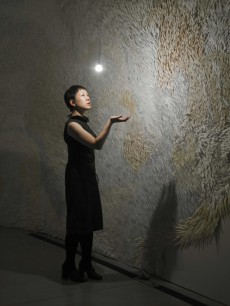
撮影:山本糾
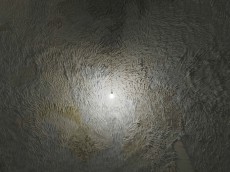
fig.1
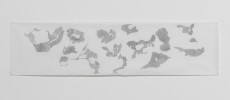

fig.2
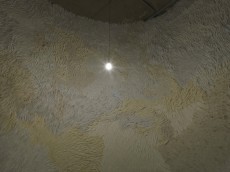
fig.3

Exchange ―Planting the seed
October 26 – December 15, 2013
YAMASAKI Ami
山崎 阿弥

SONG / the animal in man, RHYTHM photo: YAMAMOTO Tadasu
Production Scene
KONDO Yuki
Gallery A of ACAC has a special acoustic feature as it is curved like a half-doughnut, 6 meters high. This form reflects sounds intricately: you hear belated sound from somewhere unexpectedly, or a whisper spoken near the entrance goes sharply around the curve and is heard as if it were spoken beside you near the exit. And the exit is not visible from the entrance. In the gallery, therefore, dramatic sounds are produced due to reverberations. At the same time, sounds of a musical piece of fast tempo for instance get mixed up with delays and echoes so that the original melody turns unclear. What is more, as the sound does not spread uniformly from the sound source, the sound you hear is subtly different depending on where you stand.
YAMASAKI Ami who is actively working as a “voice artist” literally focusing on voice as an artist. When she presents a performance using voice, she often combines her voice with a video or an installation made as a piece of work, as well as pre-recorded sound and sound coming from an object such as a glass or shell. Through such an interaction, she sets up space and time in her work. Yamasaki who senses sounds using her “ears, vocal cords and skin as an auditory organ,”(1) began producing “SONG / the animal in man / RHYTHM” through dialogues with the sound space at ACAC. In the empty gallery, she utters a variety of voices changing pitch and loudness to confirm how and where each sound reflects or echoes. She grasps differences in sounds that she perceives as “shades,” and in order to visualize them, she sticks pieces of paper torn into the shape of a long, slender triangle which she calls “feather” on the wall. (fig.1) She does it, on the other hand, to change sound reverberations in the space because these “feathers” affect them, absorb and/or direct sounds depending on materials and shapes. For this exhibition, the wall in the right-angled corner of the gallery was made into a curve, which shows her aggressive attempt to change the gallery space. Though she changes sounds in the space, she does not mean to make reverberations sound totally different. Rather, it is kind of tuning to make sounds easier to deal with for us to hear and for her to play with.
Having no intention of reproducing or expressing some specific
subject, the artist converts the state of sounds into “feathers” in her work. As the title indicates, different shapes of torn pieces of paper and the state of these gathered pieces remind us of animal’s coat of fur. Though all collected pieces of paper are white, they have a diverse range of shades according to material and quality. As pieces of the same hue are treated as a mass and each mass flows in a certain direction, there emerge respective rhythms of the plural forms crossing on the surface. The “animal” in this piece is not confined to a resemblance in terms of appearance. The repetitive work that Yamasaki kept doing for dozens of hours resulted in something like automatic writing. Consequently, her “body was unconsciously raised and was copied to produce a beast-like pattern in a completely unexpected way.”(2) You might say that it is an image of consciousness liberated from oneself, in other words, an image related to unconsciousness and instinct. When her performance using her voice reminiscent of a bird song or a beast cry is added, there emerges, as the backdrop, a scene like a jungle or the depths of the mountains far apart from inhabited world, in which darkness, caves and animals have predominance.
Yamasaki’s voices uttered straightforward from her bodily organs sound like animals’ at times, and speaking of this exhibition, the forms are unconsciously connected with “beast.” Consequently, although both her utterance and installation are based on simple repetitions, the work reminds us of overflowing animality, primitive instinct and the expression of the unreasoning world. Using certain kinds of voices repeatedly in front of the installation, which stayed unchanged all through the exhibition period, she did not make her voice different according to her mood or feelings of the day. As her voice, which sounded like words or cries of animals varied in pitch, sound and vibration, it might have represented specific units used for exploring this place. In this meaning, each voice and each act of tearing and sticking pieces of paper can be described as the unit of the action of confirming the world surrounding us and internalizing it. Her consequent performance and installation are to externalize and substantialize what is perceived. The artist repeats these small units of confirmation persistently. In the second half of the exhibition, she disassembled pieces from the installation, an integration of the reaction of sounds and unconsciously created forms, and drew them. (She called it an act of taking out hidden beasts. (3) They are drawn with the method of piling up tiny blocks. (fig.2)
The same process applies to the installation produced this time. The installation is largely involved in creating the voice performance along with the sounds from the video and shells, and this method has been used again and again since 2008. In this respect, her installation might be considered one of the tools like shells and a glass accompanying her voice in the performance, which she repeatedly uses to perceive the world. This installation, which plays a role in changing sound, is formed as a piece of work only when her voice is brought together. In other words and strictly speaking, her work can’t be complete unless she is there. Her voice, uttered ad lib as she concentrates in a performance of improvisation, is affected by her reaction to reflections of sound at the time. That is the voice coming from a trained body with experience. Also the installation shows how she, led by such reactions, has visualized memories of experiences recorded on her body, which she calls “unconscious physicality.”(4) If so, what is going on here, conscious or unconscious, is totally and strongly concerned about herself as an individual, and her direct reaction and her direct mediation are major factors for forming her work. In this sense, both the contents and the state of the work might have been under her absolute control as an artist.
This time, however, as the show is neither a solo exhibition nor performance, and it is mainly composed of displays involving other artists’ works, it must have been difficult for her to control everything in regard to her presentation. Three light bulbs without shades hung in front of her work, looking like a dark cave, functioned as a device to make the viewer sense auditory elements visually through swaying shadows. (fig.3) Shadows moving over feathers, which look like animals’ coats of fur, make us think of heartbeats as if we were actually hearing lub-dub. It was an effect of the work and at the same time, it was an attempt to make up for the absence of the artist. It played a role as a device to emit inaudible sound. In the process of this production, a part of the installation was left to be completed by other people including volunteers for the first time. Was any change brought about in the condition of Yamasaki’s work due to the participation of others in the work and production? To say the least, viewers are able to go beyond the artist’s intention. Even if they had not viewed the sign of her unconsciousness or sounds, which she intended to communicate, they might have perceived human wish to create, to want to grasp the world, by looking at the massive amount of feathers stuck repetitively. Also they might have seen her fundamental desire to perceive the world in the likenesses of beasts. In the environment of the gallery of ACAC with a unique acoustic feature, they might have perceived sounds different from those realized by Yamasaki, using method different from Yamasaki’s. Nevertheless, this work seems inseparably linked to the body of Yamasaki herself. The change in the condition of the work caused by the artist’s presence and absence seemed to be the process of production itself, making us think of the phases of its development.
(1) According to Yamasaki’s writing for her exhibition reference.
(2) The same writing in footnote 1.
(3) Interview with Yamasaki on December 18, 2013 at ACAC.
(4) The same interview as above.

photo: YAMAMOTO Tadasu

fig.1


fig.2

fig.3

